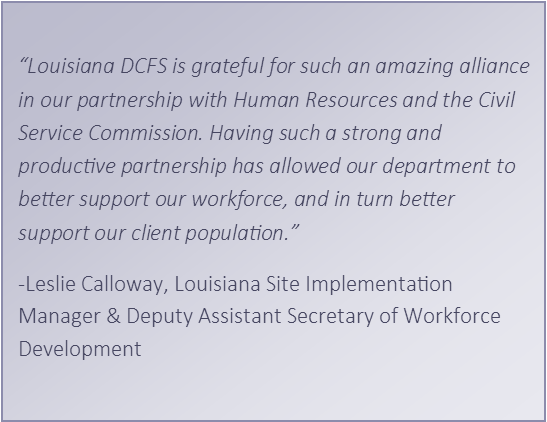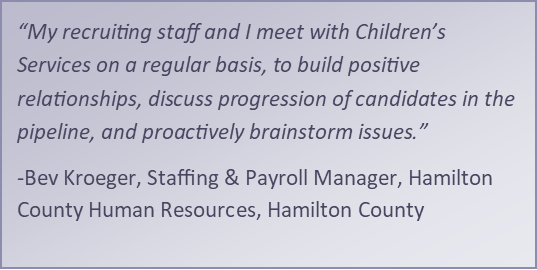Addressing the Disconnects Between HR and Child Welfare
Authors: Michelle Graef, PhD, and Maggie Thompson, MS
When it comes to efforts to improve workforce outcomes, how would you describe the relationship between human resources (HR) and child welfare leadership in your agency? Is the working relationship collaborative or are the divisions siloed? Do child welfare and HR departments routinely share information, needs, data, and expertise? Is HR involved in child welfare workforce planning and decision making? These are just a few of the questions we have explored with child welfare agencies as part of our work at the QIC-WD. Overall, agency representatives have indicated that opportunities for increased collaboration exist between these departments and that closer working relationships would enhance efforts to address the child welfare workforce needs.
What We’re Seeing
In our work with various child welfare jurisdictions, we have observed varying degrees of collaboration between HR and child welfare. In some jurisdictions, our project has benefited from existing close relationships and has facilitated stronger collaboration between HR and child welfare. For example, in Louisiana, HR and Civil Service representatives were integral to the process of establishing a new job title as part of a redesign of frontline child welfare work. These professionals were at the table from the very beginning of the needs assessment process, through the development and initial implementation of the workforce intervention. Without this collaboration, it would have been impossible for the child welfare division to conduct the necessary job analysis, develop the job classification and appropriate level of compensation, and make the business case for creating these new positions. In another example, the QIC-WD worked with a joint team of Oklahoma child welfare and HR leaders to develop a competency-based hiring process. Without the active collaboration and support of HR professionals the goals of this project could not have been accomplished.
When there is limited interaction and cooperation between HR and child welfare, it can lead to a variety of missed opportunities. In some cases, we have observed HR, child welfare, and training departments operating as separate enterprises, sometimes administratively located in entirely distinct agencies. When this is the situation, each agency’s priorities and available resources may not align. Each agency may operate their own management information systems. This can hinder the data integration that is needed to answer seemingly simple inquiries such as:
- which local university programs have produced the most successful or longest serving child welfare workers in our agency?
- what is the educational background of our current child welfare workforce?
- how many staff who left child welfare positions remained employees of the agency (in another program)?
 These types of questions, which require a cross-system integration of data about past job applicants, employee demographics, personnel performance, training records, or employee job transfers across government agencies, are often difficult for child welfare agencies to answer, and yet are important to inform strategic workforce planning. This phenomenon appears to be fueled by organizational culture and systems that carve out rigid role structures that fail to 1) cohesively align with the overarching, shared mission of the agency, and 2) facilitate the kind of proactive, critical thinking that leads to productive strategic planning.
These types of questions, which require a cross-system integration of data about past job applicants, employee demographics, personnel performance, training records, or employee job transfers across government agencies, are often difficult for child welfare agencies to answer, and yet are important to inform strategic workforce planning. This phenomenon appears to be fueled by organizational culture and systems that carve out rigid role structures that fail to 1) cohesively align with the overarching, shared mission of the agency, and 2) facilitate the kind of proactive, critical thinking that leads to productive strategic planning.
Collaborative barriers may also be the result of staff who are working with limited time, expertise, and resources in a crisis-oriented domain, which does not always align well with the goals of collaboration. In practice, this may look like:
- a lack of understanding about each department’s unique skills and needs, such as when certain types of data systems integration require computer resources that are lacking or when analyses require specialized HR analyst skills that the department may not possess.
- a lack of knowledge about the interdependence of child welfare and HR departments, such as when a child welfare agency leader wishes to implement a new program of retention bonuses for staff but then learns this practice would be in conflict with HR or union rules. Or in larger agency systems, HR policy or practice changes may not be well communicated before they are announced to the field. As one HR professional in a child welfare agency stated, “For me, the most frustration comes from not always being included in changes before they are made and released to field staff. The lack of communication between the various divisions can cause problems for implementation of the change in the field.”
- inaccurate assumptions about the state of the agency’s workforce, and reactive decision making that does not always address the underlying needs of the workforce and agency. For example, if the state administrative agency that handles all initial applications and makes initial screening decisions for state government positions regularly purges records of past unhired applicants to save file storage capacity, without understanding that these data could be used to help the child welfare agency assess the effectiveness of their staff recruitment strategies.
At a higher level, operating in siloes leaves little room for departments to collaboratively use their respective knowledge and data to investigate how workforce characteristics interact with the child welfare process and outcomes.
The QIC-WD has found that HR leaders, staff, and data are often not well integrated into child welfare agency workforce development processes. When asked to think about these partnerships, agencies acknowledge the potential value of enhanced collaboration. Among agency applications to participate in the QIC-WD Child Welfare Workforce Analytics Institute, half specifically mentioned the need to establish or strengthen the relationship and/or level of collaboration between HR and child welfare. Within these applications, needs were identified around HR and child welfare departments collaborating to track meaningful data, to detect important trends in the data, and to use the information gathered to inform effective strategies for workforce recruitment and retention.
The QIC-WD (funded by the Children’s Bureau) is not the only national organization seeing and working to address the disconnect between child welfare and HR divisions. According to the Annie E. Casey Foundation “collaboration with HR is not only possible, it is critical to your child welfare agency’s success in building the competent, flexible, available workforce you need to serve a community’s children and families.” This collaborative approach can provide agency leaders with the ability to make more data-driven decisions about their workforce, to better evaluate the impacts of those decisions, and to produce new insights to inform the selection of workforce interventions and strategies.
Looking Ahead
A variety of approaches can be used to create and enhance partnerships between HR and child welfare. For agencies that are interested in incorporating workforce analytics into their efforts, the QIC-WD offers guidance on how to establish a team comprised of members from both entities, to develop goals and an action plan for addressing workforce issues. For example, as a key component of the workforce development process, the QIC-WD teams worked to bring HR to the table. Specifically, HR leaders were included as key stakeholders in needs assessment, intervention, measurement, analysis, and reporting processes. This encouraged more informed decision making on the part of agencies and our team, while supporting more efficient integration of key HR data with other sources (e.g., child welfare).
 A number of additional suggestions have been offered by our QIC-WD sites. Common themes are that improving the disconnect between HR and child welfare requires establishing positive relationships, building mutual understanding, and creating access. Consider these ideas:
A number of additional suggestions have been offered by our QIC-WD sites. Common themes are that improving the disconnect between HR and child welfare requires establishing positive relationships, building mutual understanding, and creating access. Consider these ideas:
- Child welfare managers should identify and build a relationship with a “go-to” person within HR for each type of action (e.g., filling a vacancy, performance issues, compensation, etc.) before you need them. Having an established positive relationship will make it easier to handle an urgent or critical HR issue when one occurs.
- Schedule a monthly check-in meeting, such as a brown-bag lunch, between HR and child welfare managers (including program areas such as hotline, initial assessment, ongoing, foster care). The purpose is to build positive relationships and develop mutual understanding in a relaxed, conversational manner. The meeting can be used to review progress on hiring for vacant positions, or proactively discuss issues that may be on the horizon.
- Have designated enthusiastic, positive, child welfare workers join HR recruiters at local job fairs or university career fairs. This is a great way for child welfare field representatives to see and hear what HR does and for HR in turn to hear child welfare staff describe the joys and struggles of their job to potential job applicants. Both parties gain awareness and appreciation of the challenges and importance of the other’s role in a relaxed environment outside of the office.
- When new child welfare leaders begin in their job, HR representatives should take the initiative and start the relationship off on a positive note. Schedule an in-person meeting to get to know each other and build understanding of each other’s roles and needs. Provide child welfare leaders with easy access so that they can see and meet with you readily on a proactive, rather than reactive basis.
- Consider the possibility of having designated HR representatives co-located in or near the child welfare leadership offices. The goal is to facilitate easy access. Having an office in close proximity to child welfare leaders will lead to natural opportunities to build positive relationships and strategic partnership.
 HR units should consider providing a limited number of designated child welfare managers with full access to HR data reports on certain key areas, such as turnover by supervisory unit or employee time off summaries. Confidential data such as disciplinary actions or performance reviews would not be included in this access. These select individuals would then be able to run reports themselves on HR data as they are needed, rather than having to request the report from HR. Hamilton County (OH) Children’s Services has established such a program, and the HR representative there says this arrangement demonstrates respect and partnership between HR and child welfare, and furthers the goals of enabling child welfare managers to use HR data for workforce improvement.
HR units should consider providing a limited number of designated child welfare managers with full access to HR data reports on certain key areas, such as turnover by supervisory unit or employee time off summaries. Confidential data such as disciplinary actions or performance reviews would not be included in this access. These select individuals would then be able to run reports themselves on HR data as they are needed, rather than having to request the report from HR. Hamilton County (OH) Children’s Services has established such a program, and the HR representative there says this arrangement demonstrates respect and partnership between HR and child welfare, and furthers the goals of enabling child welfare managers to use HR data for workforce improvement.
The Annie E. Casey Foundation’s Five Steps to a Stronger Child Welfare Workforce offers valuable guidance on partnering with HR as a critical first step in workforce improvement. Additional resources from the QIC-WD’s Child Welfare Workforce Analytics Institute also provide guidance related to better use of workforce data. Collectively, these resources can be used to begin conversations about how to better integrate the knowledge and skills of child welfare and HR departments, with the goal of developing a diverse, progressive, and efficient workforce and child welfare system.
This product was funded through the Department of Health and Human Services, Administration for Children and Families, Children’s Bureau, Grant # HHS-2016-ACF-ACYF-CT-1178. The content of this publication does not necessarily reflect the views or policies of the funder, nor does mention of trade names, commercial products, or organizations imply endorsement by the US Department of Health and Human Services.